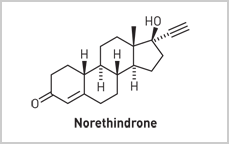- Purpose
- Hormone
Oral Contraceptives
At the 1974 ceremony granting an honorary doctorate to Carl Djerassi, who is known as the Father of the Pill, the president of Columbia University noted that perhaps the most significant impact of Djerassi's oral contraceptive research had been on the emancipation of women. "He had barely finished that sentence when the entire student body of Barnard, the women's college of Columbia, interrupted the president's address by rising in unison and shouting 'Yeah!' As soon as the women had calmed down, a second cresting human wave arose: the graduating seniors of the then all-male Columbia College. 'Yeah!' they thundered, fisted right arms thrust in the air" (Djerassi, Carl, "Steroids Made It Possible," American Chemical Society, 1990).
Since antiquity, women have ingested every manner of substance--herbs and other plants, lead, mercury, copper, gunpowder, and the organs of various animals--to achieve birth control. In the 1930s, Russell Marker of Pennsylvania State University found that, for hundreds of years, Mexican women had been eating wild yams of the Dioscorea genus for contraception, apparently successfully. Marker determined that a sapogenin, diosgenin, is abundant in the yams. This compound has a chemical structure that is similar to that of progesterone, which had previously been demonstrated to stop ovulation in rabbits. Marker succeeded in producing progesterone from the diosgenin raw material in the early 1940s. But progesterone itself is destroyed by the digestive system when taken orally. A chemical analog was needed. It was in Djerassi's lab at Syntex in Mexico City that the first chemical synthesis of an oral contraceptive steroid, norethindrone, was achieved in 1951.
In 1950, Gregory Goodwin Pincus, a biologist at the Worcester Foundation for Experimental Biology, in Massachusetts, was invited by the Planned Parenthood Federation of America to develop an "ideal" contraceptive: one that would be "harmless, entirely reliable, simple, practical, universally applicable, and aesthetically satisfactory to both husband and wife." During the 1950s, Pincus was studying norethindrone, which had been sent to him by Djerassi in 1953, and its double-bond isomer, norethynodrel, in animals.
Margaret Sanger, women's rights advocate and founder of the organization that became Planned Parenthood, was in her 80s in 1950, but she was determined to raise money for contraception research. In 1953, she brought her friend Katharine Dexter McCormick, who was one of the first women graduates of Massachusetts Institute of Technology and an heiress, to visit Pincus and tour his lab. Soon after, McCormick began contributing $150,000 to $180,000 per year, eventually reaching a grand total of $2 million.
McCormick also funded the first clinical trials, which were conducted by John Rock, a gynecologist, with patients in his private practice. In 1956, Science announced the success of Rock's clinical trials, and Rock came to be regarded as a codeveloper of the Pill.
On May 9, 1960, the Food & Drug Administration approved norethindrone, but it was not the first oral contraceptive to be marketed. G. D. Searle & Co. was the first on the market with Enovid. In 1960, Frank B. Colton, a research chemist at Searle, had developed Enovid, which contains mestranol and norethynodrel. But by 1964, norethindrone had become the most widely used active ingredient of the Pill.
FATHER OF THE PILL Carl Djerassi, who synthesized norethindrone, the basis of the first effective oral contraceptive. |
TWO YEARS after Enovid hit the market, 1.2 million American women were using the Pill; in 1965, 5 million; and in 1973, about 10 million. In 1993, the British weekly The Economist listed the Pill as one of the seven wonders of the modern world. It has also been called one of the major turning points in the social history of mankind. It was a huge factor in the rebirth of feminism in the 1960s.
The enormous strides that women have taken in education and career options most certainly would not have been possible without the ability to control pregnancy and family size. Beginning in 1972, the fraction of college women marrying a year or two after graduation plummeted. By the mid-1970s, the ratio of women to men had increased in every profession. Likewise, the age of first marriage steadily increased. Thus, the Pill brought about indisputable change in the economic and social status of women.
The hormones in the Pill have several mechanisms of action: They prevent ovulation, thicken the mucus in the cervix to inhibit sperm from reaching the egg, and make the uterus less likely to accept implantation of a fertilized egg. For women who always use the Pill correctly, the effectiveness rate is 99%. Overall, the effectiveness rate is 95%.
The Pill unquestionably improved women's health by reducing pregnancies and miscarriages. And in 1988, FDA recognized several potential noncontraceptive health benefits of the Pill: a decreased incidence of ovarian and endometrial cancers, pelvic inflammatory disease, ovarian cysts, benign breast disease, iron deficiency anemia, and dysmenorrhea.
The Pill remains the most popular method of reversible birth control in this country. It has been used by 80% of women in the U.S. at some point during their reproductive lives. Today, approximately 10.7 million American women and as many as 100 million women worldwide use the Pill.—


 )-17-Hydroxy-19-norpregn
)-17-Hydroxy-19-norpregn